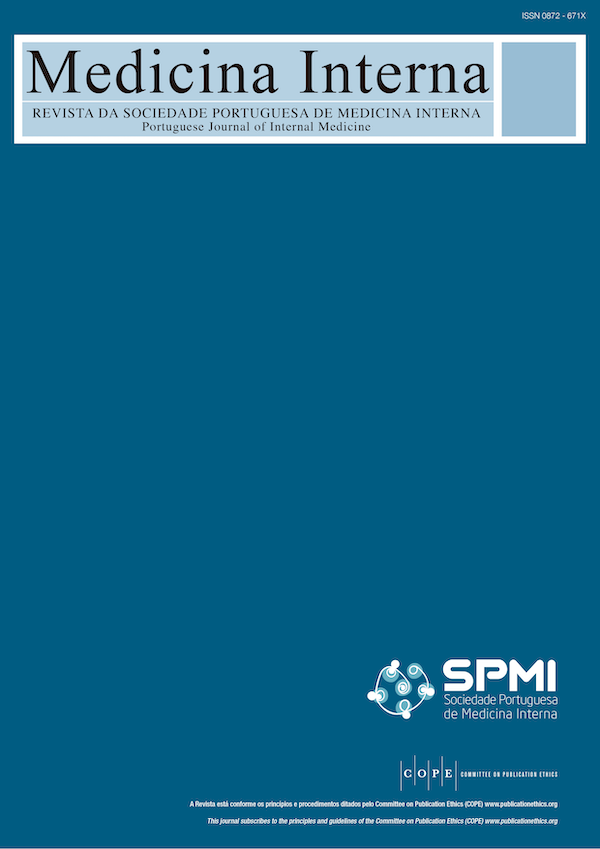Infection at The End Of Life: Is Antimicrobial Therapy of Benefit?
DOI:
https://doi.org/10.24950/rspmi/P.Vista/126/19/4/2019Keywords:
Anti-Bacterial Agents, Bacterial Infections/drug therapy, Deprescriptions, Terminal Care, Terminally IlAbstract
Palliative care includes comprehensive strategies to optimize the quality of life for patients and families confronting
terminal illness. Clinical manifestations and symptoms may
be difficult to interpret. Although inflammation may prevail,
the state of immunosenescence makes the infectious disease pauci-symptomatic and different from usual. Adynamia,
fever, and cough, are often interpreted and medicated as infection. Besides, although infection is common at the end of
life, it is often a marker of gravity and not the problem itself.
Antibiotics, usually used in this context, may not serve the
best interests of the patient and contribute to the development of resistant microorganisms, which has negative implications at the community level. In this article, we discuss
the potential benefits and risks of antibiotic therapy in this
population, which, in our opinion, should be included in the
scope of palliative care.
Downloads
References
World Health Organization. WHO Definition of Palliative Care. [Consultado a 04-06-2019]. Disponível em: https://www.who.int/cancer/palliative/definition/en/.
Albrecht JS, McGregor JC, Fromme EK, Bearden DT, Furuno JP. A nationwide analysis of antibiotic use in hospice care in the final week of life. J Pain Symptom Manage. 2013;46:483–90. doi: 10.1016/j.jpainsymman.2012.09.010.
Furuno JP, Noble BN, Fromme EK. Should we refrain from antibiotic use in hospice patients? Expert Rev Anti Infect Ther. 2016;14:277–80. doi: 10.1586/14787210.2016.1128823.
Abdel-Karim IA, Sammel RB, Prange MA. Causes of death at autopsy in an Inpatient Hospice Program. J Palliat Med. 2007;10:894–8. doi: 10.1089/ jpm.2006.0240.
Vincent J-LL, Rello J, Marshall J, Silva E, Anzueto A, Martin CD, et al. International Study of the Prevalence and Outcomes of Infection in Intensive Care Units. JAMA. 2009;302:2323–9. doi: 10.1001/jama.2009.1754.
Gonçalves-Pereira J, Pereira JMM, Ribeiro O, Baptista JPP, Froes F, Paiva JA. Impact of infection on admission and of the process of care on mortality of patients admitted to the Intensive Care Unit : the INFAUCI study. Clin Microbiol Infect. 2014;20:1308–15. doi: 10.1111/1469-0691.12738.
Furuno JP, Noble BN, Horne KN, McGregor JC, Elman MR, Bearden DT, et al. Frequency of outpatient antibiotic prescription on discharge to hospice care. Antimicrob Agents Chemother. 2014;58:5473–7. doi: 10.1128/ AAC.02873-14.
Datta R, Juthani-Mehta M. Burden and management of multidrug- -resistant organisms in palliative care. Palliat Care. 2017;10:1–6. doi: 10.1177/1178224217749233.
Juthani-Mehta M, Malani PN, Mitchell SL. Antimicrobials at the end of life: an opportunity to improve palliative care and infection management. JAMA. 2015;314:2017–8. doi: 10.1001/jama.2015.13080.
White PH, Kuhlenschmidt HL, Vancura BG, Navari RM. Antimicrobial use in patients with advanced cancer receiving hospice care. J Pain Symptom Manage. 2003;25:438–43.
Huynh TN, Kleerup EC, Wiley JF, Savitsky TD, Guse D, Garber BJ, et al. The Frequency and Cost of Treatment Perceived to Be Futile in Critical Care. JAMA Intern Med. 2013 Sep 9;1690:1–8.
Romero I, Braga B, Rodrigues J, Rodrigues R, Galriça Neto I. “Desprescrever” nos Doentes em Fim de Vida: Um Guia para Melhorar a Prática Clínica. Rev Port med Interna. 2018;25:48–57.
National Health Service. Deprescribing, a pratical guide. Consultado a 04- 06-2019. Disponível em http://www.derbyshiremedicinesmanagement.nhs. uk/assets/Clinical_Guidelines/clinical_guidelines_front_page/Deprescribing. pdf.
Thompson AJ, Silveira MJ, Vitale CA, Malani PN. Antimicrobial Use at the End of Life Among Hospitalized Patients With Advanced Cancer. Am J Hosp Palliat Med. 2012;29:599–603.
Baghban A, Juthani-Mehta M. Antimicrobial Use at the End of Life. Infect Dis Clin North Am. 2017;31:639–47.
Cardona-Morrell M, Kim JCH, Turner RM, Anstey M, Mitchell IA, Hillman K. Non-beneficial treatments in hospital at the end of life: A systematic review on extent of the problem. Int J Qual Heal Care. 2016;28:456–69.
Angus DC, Barnato AE, Linde-Zwirble WT, Weissfeld LA, Watson RS, Rickert T, et al. Use of intensive care at the end of life in the United States: An epidemiologic study. Crit Care Med. 2004;32:638–43.
Montravers P, Dufour G, Guglielminotti J, Desmard M, Muller C, Houissa H, et al. Dynamic changes of microbial flora and therapeutic consequences in persistent peritonitis. Crit Care. 2015;19:1–13.
Soares Z, Mateus D, Macedo F, Valente L, Gonçalves-Pereira J. Infeções associadas a cuidados de saúde e resistência aos antibióticos - Estudo piloto. Rev Infeção Sépsis. 2015;2:8–12.
Levin PD, Simor AE, Moses AE, Sprung CL. End-of-life treatment and bacterial antibiotic resistance: A potential association. Chest. 2010;138:588– 94.
Ubeda C, Taur Y, Jenq RR, Equinda MJ, Son T, Samstein M, et al. Vancomycin-resistant Enterococcus domination of intestinal microbiota is enabled by antibiotic treatment in mice and precedes bloodstream invasion in humans. J Clin Invest. 2010;120:4332–41.
Chih A-H, Lee L-T, Cheng S-Y, Yao C-A, Hu W-Y, Chen C-Y, et al. Is It Appropriate To Withdraw Antibiotics in Terminal Patients with Cancer with Infection? J Palliat Med. 2013;16:1417–22.
Helde-Frankling M, Bergqvist J, Bergman P, Björkhem-Bergman L. Antibiotic treatment in end-of-life cancer patients—A retrospective observational study at a palliative care center in Sweden. Cancers (Basel) 2016;8(9):1–10.
Oh DY, Kim JH, Kim DW, et al. Antibiotic use during the last days of life in cancer patients. Eur J Cancer Care 2006;15:74–9.
Macedo F, Nunes C, Ladeira K, Pinho F, Saraiva N, Bonito N, et al. Antimicrobial therapy in palliative care: an overview. Support Care Cancer. 2018;26:1361–7
.
Ahronheim JC, Morrison RS, Baskin SA, Morris J, Meier DE. Treatment of the Dying in the Acute Care Hospital. Arch Intern Med 1996;156:2094–100.
Lecuyer L, Chevret S, Thiery G, Darmon M, Schlemmer B, Azoulay É. The ICU Trial: A new admission policy for cancer patients requiring mechanical ventilation. Crit Care Med. 2007;35:808–14.
Beumier M, Casu G, Hites M, Wolff F, Cotton F, Vincent J-L, et al. Elevated β-lactam concentrations associated with neurological deterioration in ICU septic patients. Minerva Anestesiol. 2015;81:497–506.
Downloads
Published
How to Cite
Issue
Section
License

This work is licensed under a Creative Commons Attribution 4.0 International License.
Copyright (c) 2023 Medicina Interna






